Organizational Culture and Performance Management: A Detailed Analysis
VerifiedAdded on 2022/08/08
|6
|1819
|17
Homework Assignment
AI Summary
This assignment explores the multifaceted aspects of organizational culture, emphasizing the development of performance plans, processes for addressing and resolving team-related issues, and effective communication strategies. The assignment delves into establishing key organizational goals, assigning tasks, and implementing supply chain management systems to enhance workplace performance. It also covers maintaining work ethics, conflict resolution, and stakeholder communication. Furthermore, the document examines the importance of adjusting interpersonal communication styles to align with an organization's cultural diversity and ethical environment, while also discussing relevant legislation and regulations. The student provides detailed steps for managing conflict, consensus-building, and leveraging networks to support team and organizational outcomes, providing a comprehensive overview of organizational dynamics and leadership management.
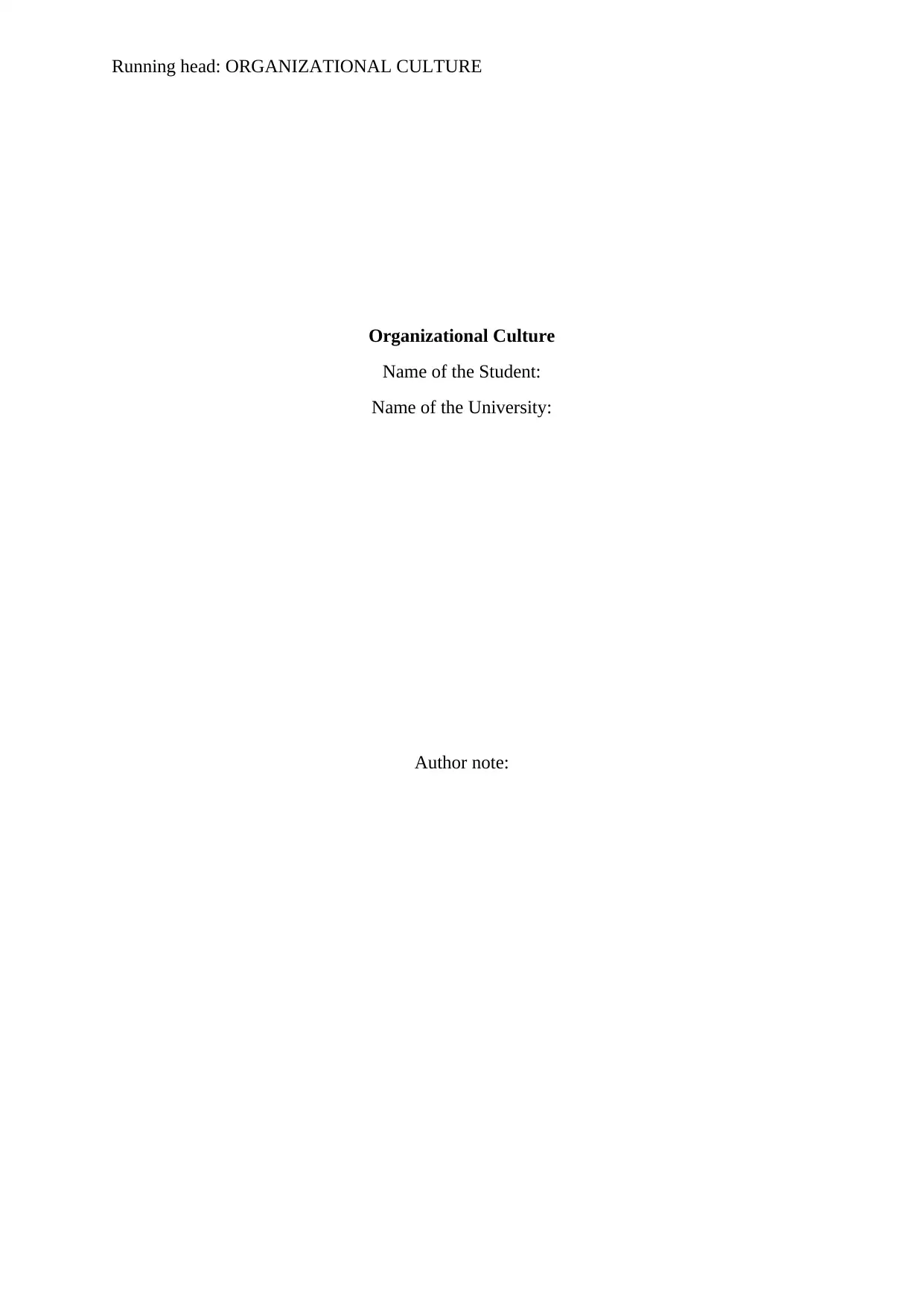
Running head: ORGANIZATIONAL CULTURE
Organizational Culture
Name of the Student:
Name of the University:
Author note:
Organizational Culture
Name of the Student:
Name of the University:
Author note:
Paraphrase This Document
Need a fresh take? Get an instant paraphrase of this document with our AI Paraphraser
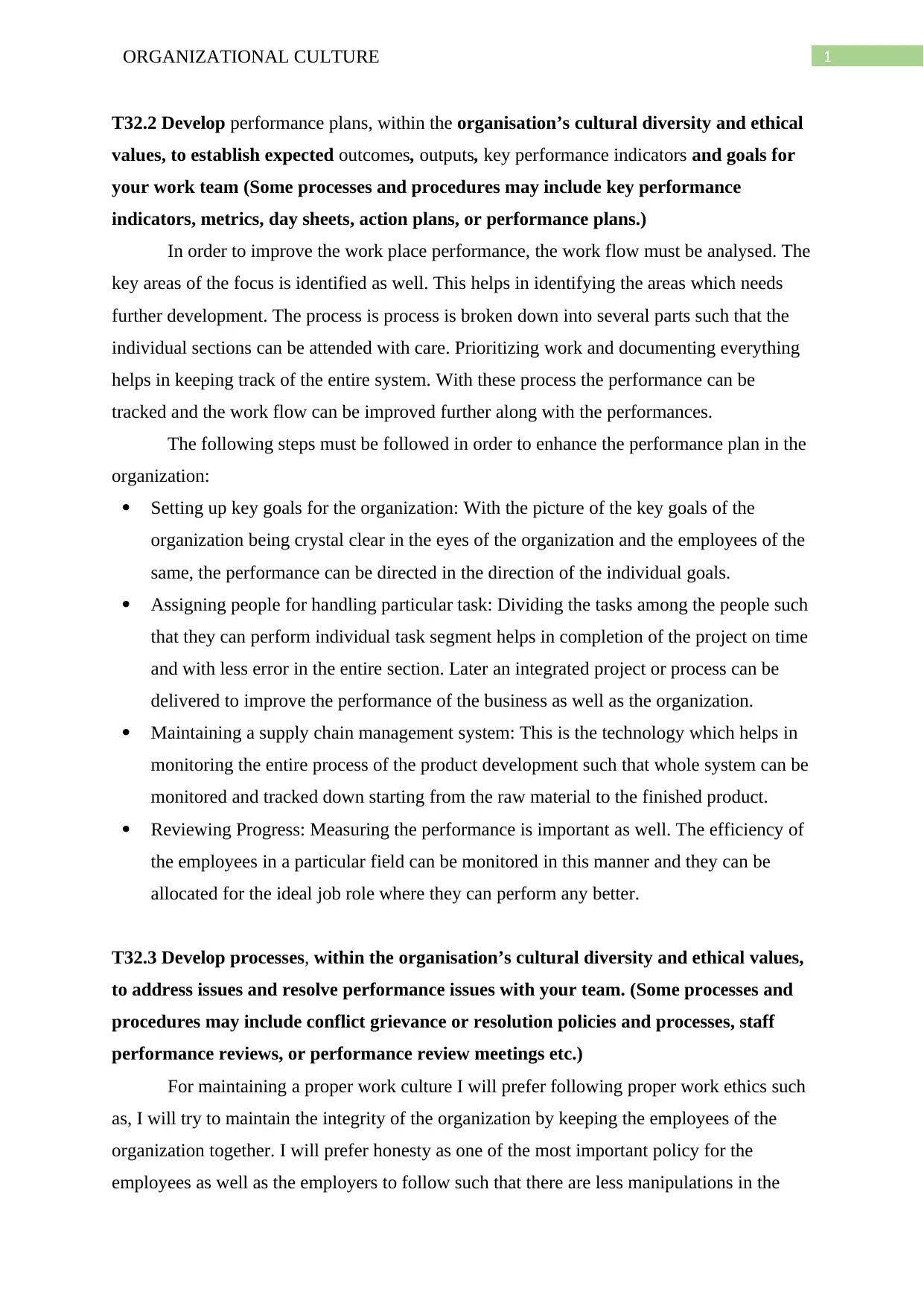
1ORGANIZATIONAL CULTURE
T32.2 Develop performance plans, within the organisation’s cultural diversity and ethical
values, to establish expected outcomes, outputs, key performance indicators and goals for
your work team (Some processes and procedures may include key performance
indicators, metrics, day sheets, action plans, or performance plans.)
In order to improve the work place performance, the work flow must be analysed. The
key areas of the focus is identified as well. This helps in identifying the areas which needs
further development. The process is process is broken down into several parts such that the
individual sections can be attended with care. Prioritizing work and documenting everything
helps in keeping track of the entire system. With these process the performance can be
tracked and the work flow can be improved further along with the performances.
The following steps must be followed in order to enhance the performance plan in the
organization:
Setting up key goals for the organization: With the picture of the key goals of the
organization being crystal clear in the eyes of the organization and the employees of the
same, the performance can be directed in the direction of the individual goals.
Assigning people for handling particular task: Dividing the tasks among the people such
that they can perform individual task segment helps in completion of the project on time
and with less error in the entire section. Later an integrated project or process can be
delivered to improve the performance of the business as well as the organization.
Maintaining a supply chain management system: This is the technology which helps in
monitoring the entire process of the product development such that whole system can be
monitored and tracked down starting from the raw material to the finished product.
Reviewing Progress: Measuring the performance is important as well. The efficiency of
the employees in a particular field can be monitored in this manner and they can be
allocated for the ideal job role where they can perform any better.
T32.3 Develop processes, within the organisation’s cultural diversity and ethical values,
to address issues and resolve performance issues with your team. (Some processes and
procedures may include conflict grievance or resolution policies and processes, staff
performance reviews, or performance review meetings etc.)
For maintaining a proper work culture I will prefer following proper work ethics such
as, I will try to maintain the integrity of the organization by keeping the employees of the
organization together. I will prefer honesty as one of the most important policy for the
employees as well as the employers to follow such that there are less manipulations in the
T32.2 Develop performance plans, within the organisation’s cultural diversity and ethical
values, to establish expected outcomes, outputs, key performance indicators and goals for
your work team (Some processes and procedures may include key performance
indicators, metrics, day sheets, action plans, or performance plans.)
In order to improve the work place performance, the work flow must be analysed. The
key areas of the focus is identified as well. This helps in identifying the areas which needs
further development. The process is process is broken down into several parts such that the
individual sections can be attended with care. Prioritizing work and documenting everything
helps in keeping track of the entire system. With these process the performance can be
tracked and the work flow can be improved further along with the performances.
The following steps must be followed in order to enhance the performance plan in the
organization:
Setting up key goals for the organization: With the picture of the key goals of the
organization being crystal clear in the eyes of the organization and the employees of the
same, the performance can be directed in the direction of the individual goals.
Assigning people for handling particular task: Dividing the tasks among the people such
that they can perform individual task segment helps in completion of the project on time
and with less error in the entire section. Later an integrated project or process can be
delivered to improve the performance of the business as well as the organization.
Maintaining a supply chain management system: This is the technology which helps in
monitoring the entire process of the product development such that whole system can be
monitored and tracked down starting from the raw material to the finished product.
Reviewing Progress: Measuring the performance is important as well. The efficiency of
the employees in a particular field can be monitored in this manner and they can be
allocated for the ideal job role where they can perform any better.
T32.3 Develop processes, within the organisation’s cultural diversity and ethical values,
to address issues and resolve performance issues with your team. (Some processes and
procedures may include conflict grievance or resolution policies and processes, staff
performance reviews, or performance review meetings etc.)
For maintaining a proper work culture I will prefer following proper work ethics such
as, I will try to maintain the integrity of the organization by keeping the employees of the
organization together. I will prefer honesty as one of the most important policy for the
employees as well as the employers to follow such that there are less manipulations in the
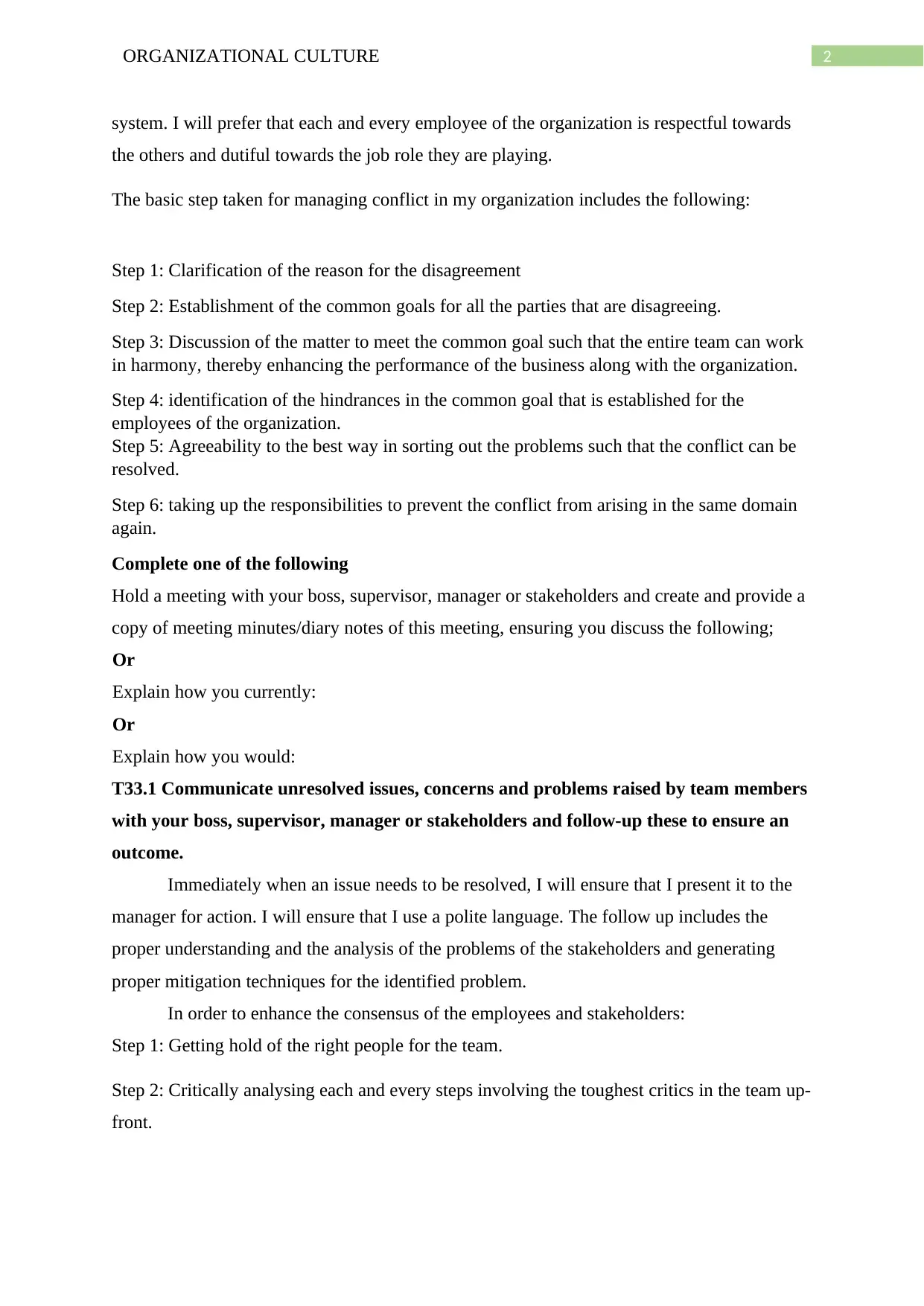
2ORGANIZATIONAL CULTURE
system. I will prefer that each and every employee of the organization is respectful towards
the others and dutiful towards the job role they are playing.
The basic step taken for managing conflict in my organization includes the following:
Step 1: Clarification of the reason for the disagreement
Step 2: Establishment of the common goals for all the parties that are disagreeing.
Step 3: Discussion of the matter to meet the common goal such that the entire team can work
in harmony, thereby enhancing the performance of the business along with the organization.
Step 4: identification of the hindrances in the common goal that is established for the
employees of the organization.
Step 5: Agreeability to the best way in sorting out the problems such that the conflict can be
resolved.
Step 6: taking up the responsibilities to prevent the conflict from arising in the same domain
again.
Complete one of the following
Hold a meeting with your boss, supervisor, manager or stakeholders and create and provide a
copy of meeting minutes/diary notes of this meeting, ensuring you discuss the following;
Or
Explain how you currently:
Or
Explain how you would:
T33.1 Communicate unresolved issues, concerns and problems raised by team members
with your boss, supervisor, manager or stakeholders and follow-up these to ensure an
outcome.
Immediately when an issue needs to be resolved, I will ensure that I present it to the
manager for action. I will ensure that I use a polite language. The follow up includes the
proper understanding and the analysis of the problems of the stakeholders and generating
proper mitigation techniques for the identified problem.
In order to enhance the consensus of the employees and stakeholders:
Step 1: Getting hold of the right people for the team.
Step 2: Critically analysing each and every steps involving the toughest critics in the team up-
front.
system. I will prefer that each and every employee of the organization is respectful towards
the others and dutiful towards the job role they are playing.
The basic step taken for managing conflict in my organization includes the following:
Step 1: Clarification of the reason for the disagreement
Step 2: Establishment of the common goals for all the parties that are disagreeing.
Step 3: Discussion of the matter to meet the common goal such that the entire team can work
in harmony, thereby enhancing the performance of the business along with the organization.
Step 4: identification of the hindrances in the common goal that is established for the
employees of the organization.
Step 5: Agreeability to the best way in sorting out the problems such that the conflict can be
resolved.
Step 6: taking up the responsibilities to prevent the conflict from arising in the same domain
again.
Complete one of the following
Hold a meeting with your boss, supervisor, manager or stakeholders and create and provide a
copy of meeting minutes/diary notes of this meeting, ensuring you discuss the following;
Or
Explain how you currently:
Or
Explain how you would:
T33.1 Communicate unresolved issues, concerns and problems raised by team members
with your boss, supervisor, manager or stakeholders and follow-up these to ensure an
outcome.
Immediately when an issue needs to be resolved, I will ensure that I present it to the
manager for action. I will ensure that I use a polite language. The follow up includes the
proper understanding and the analysis of the problems of the stakeholders and generating
proper mitigation techniques for the identified problem.
In order to enhance the consensus of the employees and stakeholders:
Step 1: Getting hold of the right people for the team.
Step 2: Critically analysing each and every steps involving the toughest critics in the team up-
front.
⊘ This is a preview!⊘
Do you want full access?
Subscribe today to unlock all pages.

Trusted by 1+ million students worldwide
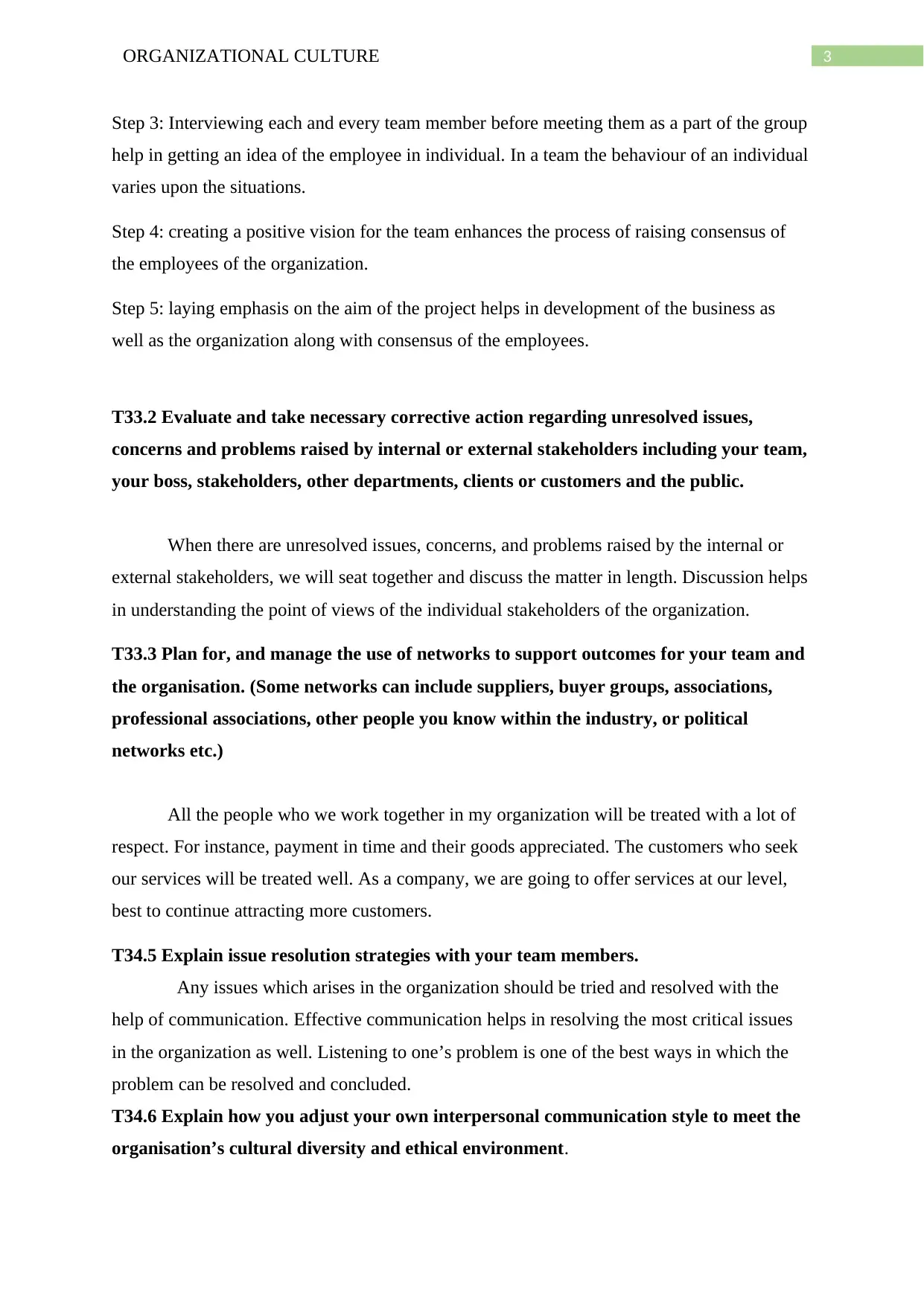
3ORGANIZATIONAL CULTURE
Step 3: Interviewing each and every team member before meeting them as a part of the group
help in getting an idea of the employee in individual. In a team the behaviour of an individual
varies upon the situations.
Step 4: creating a positive vision for the team enhances the process of raising consensus of
the employees of the organization.
Step 5: laying emphasis on the aim of the project helps in development of the business as
well as the organization along with consensus of the employees.
T33.2 Evaluate and take necessary corrective action regarding unresolved issues,
concerns and problems raised by internal or external stakeholders including your team,
your boss, stakeholders, other departments, clients or customers and the public.
When there are unresolved issues, concerns, and problems raised by the internal or
external stakeholders, we will seat together and discuss the matter in length. Discussion helps
in understanding the point of views of the individual stakeholders of the organization.
T33.3 Plan for, and manage the use of networks to support outcomes for your team and
the organisation. (Some networks can include suppliers, buyer groups, associations,
professional associations, other people you know within the industry, or political
networks etc.)
All the people who we work together in my organization will be treated with a lot of
respect. For instance, payment in time and their goods appreciated. The customers who seek
our services will be treated well. As a company, we are going to offer services at our level,
best to continue attracting more customers.
T34.5 Explain issue resolution strategies with your team members.
Any issues which arises in the organization should be tried and resolved with the
help of communication. Effective communication helps in resolving the most critical issues
in the organization as well. Listening to one’s problem is one of the best ways in which the
problem can be resolved and concluded.
T34.6 Explain how you adjust your own interpersonal communication style to meet the
organisation’s cultural diversity and ethical environment.
Step 3: Interviewing each and every team member before meeting them as a part of the group
help in getting an idea of the employee in individual. In a team the behaviour of an individual
varies upon the situations.
Step 4: creating a positive vision for the team enhances the process of raising consensus of
the employees of the organization.
Step 5: laying emphasis on the aim of the project helps in development of the business as
well as the organization along with consensus of the employees.
T33.2 Evaluate and take necessary corrective action regarding unresolved issues,
concerns and problems raised by internal or external stakeholders including your team,
your boss, stakeholders, other departments, clients or customers and the public.
When there are unresolved issues, concerns, and problems raised by the internal or
external stakeholders, we will seat together and discuss the matter in length. Discussion helps
in understanding the point of views of the individual stakeholders of the organization.
T33.3 Plan for, and manage the use of networks to support outcomes for your team and
the organisation. (Some networks can include suppliers, buyer groups, associations,
professional associations, other people you know within the industry, or political
networks etc.)
All the people who we work together in my organization will be treated with a lot of
respect. For instance, payment in time and their goods appreciated. The customers who seek
our services will be treated well. As a company, we are going to offer services at our level,
best to continue attracting more customers.
T34.5 Explain issue resolution strategies with your team members.
Any issues which arises in the organization should be tried and resolved with the
help of communication. Effective communication helps in resolving the most critical issues
in the organization as well. Listening to one’s problem is one of the best ways in which the
problem can be resolved and concluded.
T34.6 Explain how you adjust your own interpersonal communication style to meet the
organisation’s cultural diversity and ethical environment.
Paraphrase This Document
Need a fresh take? Get an instant paraphrase of this document with our AI Paraphraser
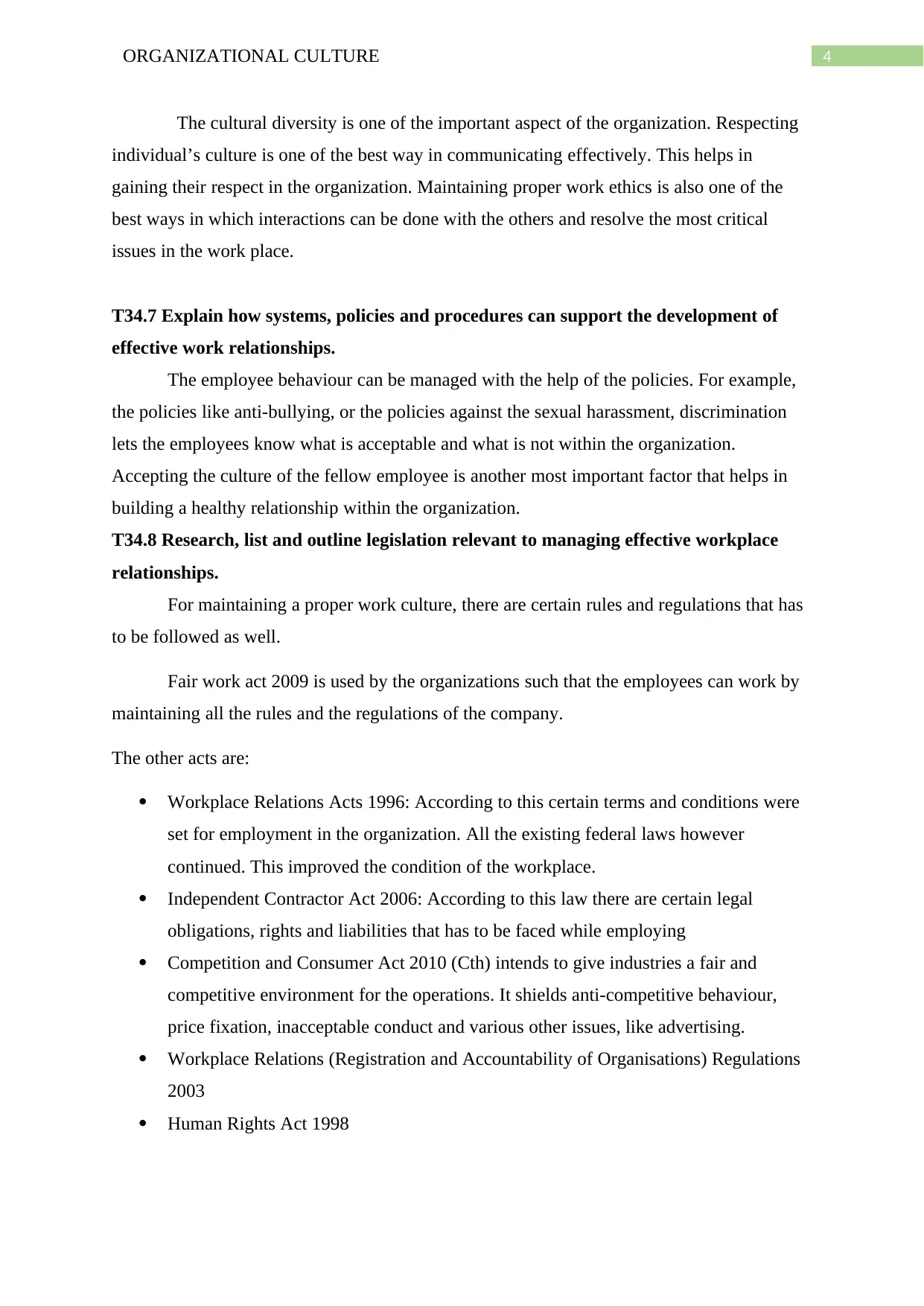
4ORGANIZATIONAL CULTURE
The cultural diversity is one of the important aspect of the organization. Respecting
individual’s culture is one of the best way in communicating effectively. This helps in
gaining their respect in the organization. Maintaining proper work ethics is also one of the
best ways in which interactions can be done with the others and resolve the most critical
issues in the work place.
T34.7 Explain how systems, policies and procedures can support the development of
effective work relationships.
The employee behaviour can be managed with the help of the policies. For example,
the policies like anti-bullying, or the policies against the sexual harassment, discrimination
lets the employees know what is acceptable and what is not within the organization.
Accepting the culture of the fellow employee is another most important factor that helps in
building a healthy relationship within the organization.
T34.8 Research, list and outline legislation relevant to managing effective workplace
relationships.
For maintaining a proper work culture, there are certain rules and regulations that has
to be followed as well.
Fair work act 2009 is used by the organizations such that the employees can work by
maintaining all the rules and the regulations of the company.
The other acts are:
Workplace Relations Acts 1996: According to this certain terms and conditions were
set for employment in the organization. All the existing federal laws however
continued. This improved the condition of the workplace.
Independent Contractor Act 2006: According to this law there are certain legal
obligations, rights and liabilities that has to be faced while employing
Competition and Consumer Act 2010 (Cth) intends to give industries a fair and
competitive environment for the operations. It shields anti-competitive behaviour,
price fixation, inacceptable conduct and various other issues, like advertising.
Workplace Relations (Registration and Accountability of Organisations) Regulations
2003
Human Rights Act 1998
The cultural diversity is one of the important aspect of the organization. Respecting
individual’s culture is one of the best way in communicating effectively. This helps in
gaining their respect in the organization. Maintaining proper work ethics is also one of the
best ways in which interactions can be done with the others and resolve the most critical
issues in the work place.
T34.7 Explain how systems, policies and procedures can support the development of
effective work relationships.
The employee behaviour can be managed with the help of the policies. For example,
the policies like anti-bullying, or the policies against the sexual harassment, discrimination
lets the employees know what is acceptable and what is not within the organization.
Accepting the culture of the fellow employee is another most important factor that helps in
building a healthy relationship within the organization.
T34.8 Research, list and outline legislation relevant to managing effective workplace
relationships.
For maintaining a proper work culture, there are certain rules and regulations that has
to be followed as well.
Fair work act 2009 is used by the organizations such that the employees can work by
maintaining all the rules and the regulations of the company.
The other acts are:
Workplace Relations Acts 1996: According to this certain terms and conditions were
set for employment in the organization. All the existing federal laws however
continued. This improved the condition of the workplace.
Independent Contractor Act 2006: According to this law there are certain legal
obligations, rights and liabilities that has to be faced while employing
Competition and Consumer Act 2010 (Cth) intends to give industries a fair and
competitive environment for the operations. It shields anti-competitive behaviour,
price fixation, inacceptable conduct and various other issues, like advertising.
Workplace Relations (Registration and Accountability of Organisations) Regulations
2003
Human Rights Act 1998
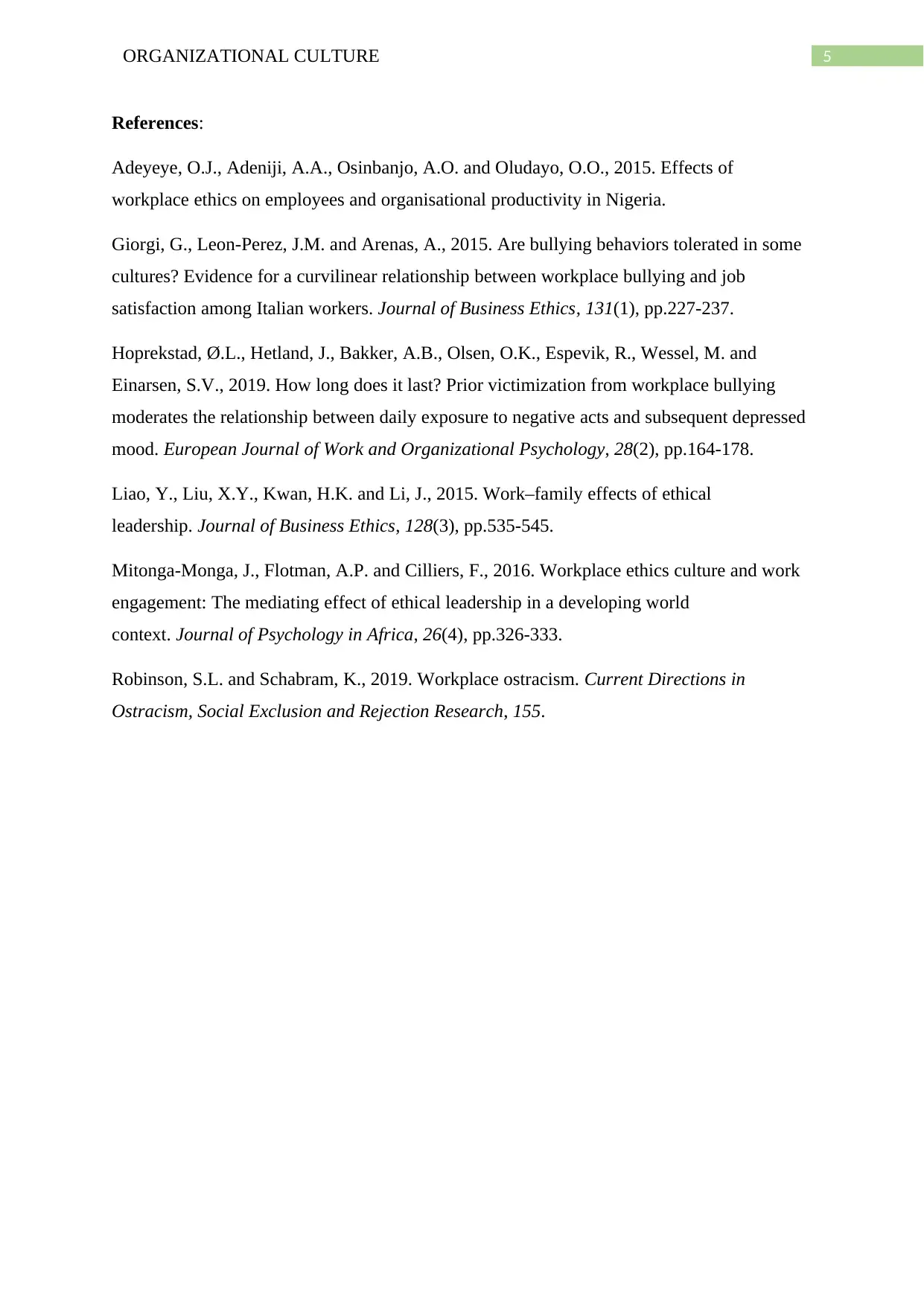
5ORGANIZATIONAL CULTURE
References:
Adeyeye, O.J., Adeniji, A.A., Osinbanjo, A.O. and Oludayo, O.O., 2015. Effects of
workplace ethics on employees and organisational productivity in Nigeria.
Giorgi, G., Leon-Perez, J.M. and Arenas, A., 2015. Are bullying behaviors tolerated in some
cultures? Evidence for a curvilinear relationship between workplace bullying and job
satisfaction among Italian workers. Journal of Business Ethics, 131(1), pp.227-237.
Hoprekstad, Ø.L., Hetland, J., Bakker, A.B., Olsen, O.K., Espevik, R., Wessel, M. and
Einarsen, S.V., 2019. How long does it last? Prior victimization from workplace bullying
moderates the relationship between daily exposure to negative acts and subsequent depressed
mood. European Journal of Work and Organizational Psychology, 28(2), pp.164-178.
Liao, Y., Liu, X.Y., Kwan, H.K. and Li, J., 2015. Work–family effects of ethical
leadership. Journal of Business Ethics, 128(3), pp.535-545.
Mitonga-Monga, J., Flotman, A.P. and Cilliers, F., 2016. Workplace ethics culture and work
engagement: The mediating effect of ethical leadership in a developing world
context. Journal of Psychology in Africa, 26(4), pp.326-333.
Robinson, S.L. and Schabram, K., 2019. Workplace ostracism. Current Directions in
Ostracism, Social Exclusion and Rejection Research, 155.
References:
Adeyeye, O.J., Adeniji, A.A., Osinbanjo, A.O. and Oludayo, O.O., 2015. Effects of
workplace ethics on employees and organisational productivity in Nigeria.
Giorgi, G., Leon-Perez, J.M. and Arenas, A., 2015. Are bullying behaviors tolerated in some
cultures? Evidence for a curvilinear relationship between workplace bullying and job
satisfaction among Italian workers. Journal of Business Ethics, 131(1), pp.227-237.
Hoprekstad, Ø.L., Hetland, J., Bakker, A.B., Olsen, O.K., Espevik, R., Wessel, M. and
Einarsen, S.V., 2019. How long does it last? Prior victimization from workplace bullying
moderates the relationship between daily exposure to negative acts and subsequent depressed
mood. European Journal of Work and Organizational Psychology, 28(2), pp.164-178.
Liao, Y., Liu, X.Y., Kwan, H.K. and Li, J., 2015. Work–family effects of ethical
leadership. Journal of Business Ethics, 128(3), pp.535-545.
Mitonga-Monga, J., Flotman, A.P. and Cilliers, F., 2016. Workplace ethics culture and work
engagement: The mediating effect of ethical leadership in a developing world
context. Journal of Psychology in Africa, 26(4), pp.326-333.
Robinson, S.L. and Schabram, K., 2019. Workplace ostracism. Current Directions in
Ostracism, Social Exclusion and Rejection Research, 155.
⊘ This is a preview!⊘
Do you want full access?
Subscribe today to unlock all pages.

Trusted by 1+ million students worldwide
1 out of 6
Related Documents
Your All-in-One AI-Powered Toolkit for Academic Success.
+13062052269
info@desklib.com
Available 24*7 on WhatsApp / Email
![[object Object]](/_next/static/media/star-bottom.7253800d.svg)
Unlock your academic potential
Copyright © 2020–2025 A2Z Services. All Rights Reserved. Developed and managed by ZUCOL.





